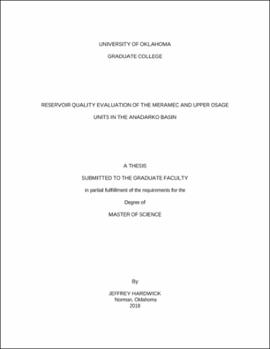| dc.description.abstract | The objective of this study is to provide a comparative look at the diagenetic evolution and reservoir quality characteristics of the Meramec and Upper Osage units in the STACK (Sooner Trend Anadarko Basin of Canadian and Kingfisher counties) and NW STACK (extension of the STACK, to the northwest, into portions of Dewey, Blaine, Woodward, and Major counties, Oklahoma). Both are hybrid unconventional plays in the Anadarko Basin of Oklahoma and consists of a complex depositional sequence of Middle Mississippian siliciclastics and carbonates of Meramecian and Osagean age as well as the Late Devonian to Early Mississippian organic-rich Woodford Shale.
Unsupervised Hierarchical Clustering Analysis (HRA) was performed to connect reservoir-scale petrophysical observations with micro-scale petrographic observations. The clustering analysis yielded five distinct electrofacies in the Meramec that represent depositional trends in mineralogy and diagenetically enhanced intervals of anomalous feldspar dissolution. Implementing HRA provided a genetic-based workflow for reservoir quality prediction and understanding. Wireline data from twelve publicly available wells with core and wireline data from seven other wells provided the framework to demonstrate the predictive workflow presented in this study.
Paleomagnetic and petrographic data were integrated to discern the diagenetic evolution of each unit. Petrographic analysis revealed a pervasive marine calcite cement in silt-dominated microfacies of the Osage and Meramec. The calcite cement significantly occluded primary porosity and created baffles for vertical fluid flow. The terrigenous input of clay partially protected primary porosity enhancing fluid flow in the more framework dominated microfacies. The primary pore-types observed in good reservoir quality microfacies include: intragranular pores in feldspars, interstitial porosity in clay, and intergranular pores in between other framework grains such as silt. Thermal demagnetization revealed a characteristic remanent magnetization (ChRM) removed at unblocking temperatures ranging from 250°C to 450°C. The ChRM displayed shallow inclinations consistent with an acquisition of approximately 300 Ma. The ChRM is interpreted as a chemical remanent magnetization (CRM) related to the emplacement of hydrocarbons; thus, providing a critical temporal component on the evolution of the petroleum system. | en_US |
